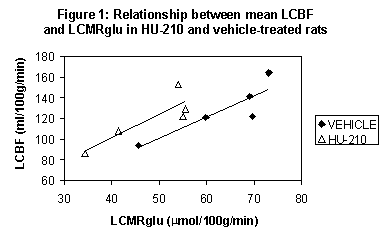| pA2 online © Copyright 2004 The British Pharmacological Society |
163P
GKT, University of London Winter Meeting December 2003 |
|
Effects
of the synthetic endocannabinoid HU-210 upon the relationship between
cerebral blood flow and metabolism in the rat |
|
In addition to their presence on central neuronal processes, cannabinoid CB1 receptors, mediating vasodilatation, have also been identified on cerebral blood vessels (Gebremedhin et al., 1999). To investigate the role of CB1 receptors in cerebro-vascular regulation, we examined the effects of the synthetic endocannabinoid HU-210 on local cerebral blood flow (LCBF) and glucose use (LCMRglu) in parallel groups of rats.
Conscious, lightly restrained adult male Dark Agouti rats were injected with either 100µg/kg i.v. HU-210 (n=12) or saline with 5% propylene glycol and 2% Tween 80 (n=12). Measure-ment of LCBF (using [14C]-iodoantipyrine) or LCMRglu (using [14C]-2-deoxyglucose) was initiated at 30 and 20 minutes after treatment, respectively (Kelly et al., 1994). Hippocampus, striatum, and three neocortical brain areas were analysed. Mean arterial blood pressure (MABP) and heart rate were monitored constantly, and blood gases measured at intervals. Data (mean±SEM) were analysed by t-test, and LCBF/ LCMRglu ratios by Mann-Whitney U-test (P<0.05).
HU-210 treatment decreased MABP (from 142±1 to 105±6 mmHg) and heart rate (from 484±6 to 232±18 beats.min-1), and increased PaCO2 (from 32.0±0.7 to 45.7±1.6 mmHg). These changes were established by 5 minutes and persisted throughout the experiment.
HU-210 induced significant decreases in LCMRglu in all five brain regions examined, ranging from -19% in frontal cortex to -31% in occipital cortex. In contrast, there was a tendency for LCBF to increase in all regions following HU-210. However, hypercapnia alone results in cerebral vasodilation and increased cerebral blood flow. With a correction factor introduced to allow for this, LCBF was found not to be significantly different from control, despite decreases in metabolism. Thus, HU-210 administration was associated with a change in the fundamental relationship that normally links cerebral perfusion to metabolic demand (see Fig1).

the consistent increase in LCBF/ LCMRglu ratios throughout the brain suggests that, as well as its depressant effects on neuronal activity, HU-210 may also interact with cerebro-vascular CB1 receptors to produce dilatatory effects which are independent of metabolic drive.
Gebremedhin, D.,
Lange, A.R., Campbell, W.D. et al. (1999) Am. J. Physiol., 276,
H2085-2093.
Kelly P.A.T., Ritchie, I.M., Sangra, M. et al. (1994) Brain Res.,
665, 315-318.